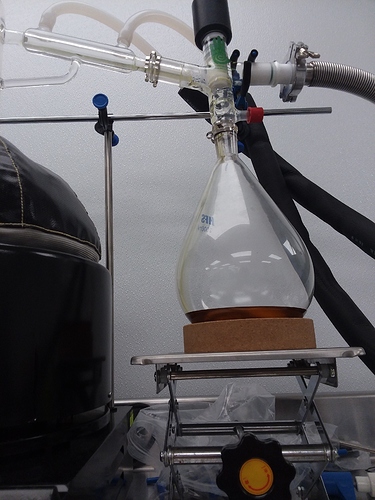That’s the short of it from what was explained to me. If you knock off all the trichombs with cold solvent, and there are cannabinoids left, where else could they be?
I know there are two types of trichomes one of which is easier to extract from than the other. I used to run CO2 extractions and did examinations of the leaf material before and after under a microscope. The CO2 always blasted open the normal bulbous trichomes but never really did much to the capitate-sessile trichomes. I think that may be where gains could be made vs. internal to the leaf. Once you blast open the leaf you unleash an unholy beast of other plant compounds including copious amounts of sugars. Not fun.
Here’s a brief article explaining the two types of trichomes:
https://www.civilized.life/articles/types-of-trichomes/
I agree with ya on that. I’ve noticed same with cold hydrocarbons, C3 and C4 “grab” the globular heads, but leave globular trich stalks, and also seem to leave the other trichome types (cant remember name) that dont have globular head. I havent looked to see how well the bulbous trichs that are close to leaf surface are extracted with cold C3 or C4. This is where I was thinking the last 5-10% yield is left, and not to cannabinoids being internal to the leaf.
Cannabinoids that are outside the trichomes, are most likely absorbed into the other plant parts rather than produced there. Any broken trichomes will spill their contents and that material will be absorbed by cellulose etc. A cold solvent would be far less efficient at penetrating the plant material to release this absorbed material. The less the material is disturbed, the more likely you will get a highly efficient extraction with cold solvent.
Did you get that tested? I bet it’s at least 65%
Looks like a turd in a toilet bowl ![]()
CO2 is the issue. We switched over to BHO and had some great results on first pass at 98%
Explain how a starting material has to do with an end result distillate potency. Imo, it’s all about when you switch flasks. Switch too early or too late, and your adding heads or tails to the mains, this lowering potency.
Nope
Winterizing co2 extract is a art on it s own ( i do not recomend learning)
Realy co 2 crude is a diffrent ball game
Defenatly if he that pushes the butons has no cleu or is lazy
Thanks for this post! Only just got into the industry. Any good mantle recommendations? The mantle I have jumps the set value by 10-15c every time. This particular mantle is from USA Labs.
Well it ain t cheap but summits is the best at the moment by far
But @Demontrich is very happy with his and he can judge gear so thats probably a good choice to
They are the cannabinoids you extracted from the surface, just soaked into material with the solvent and then dried. Once dried, they obviously are on the inside as well but the lot did not start there.
Cannabinoids are not produced in cells other then the trichome. Mutations mean that yes very small amounts will be made other places randomly but it is not significant(think ppm even ppb levels throughout entire plant)
Which usa lab mantle do you have? The elcheapo tan circular one, or the upgrade black (blue is old version) case mantle?
I run their black case mantle and love it. No issues so far.
I have the USA Lab black mantle. It just seems to always overshoot the set value.
The photo doesn’t show all of it, but it is there on the left.
Edit: posted at 10:03 pm. not near lab to take a better picture.
I know this is an old thread lol but what’s the e30?
edwards 30?
That’s the upgraded black case. Did you burn it in with the supplied black plug in the back?
If its over shooting, call david and mention it.
I don’t have all the answers, but one major issue I discovered with regards to starting material is any contamination, such as sulfur from “organic” growers. This is something I learned the hard way to beware of when sourcing material. I had an unexpected degradation issue during short path distillation with some high potency crude made from what looked like very nice material, popcorn buds that were cut with some leafy crap, but overall potency around 10% THC.
During distillation there was a noticeable sulfur smell that was stronger than normal from the vacuum exhaust. A friend tipped me off about it, and I thought back on times I have used sulfur burners in greenhouse grows to prevent powdery mildew. There are a lot of organic insecticides that use sulfur too. My hypothesis is that this sulfur is dropping pH when water is introduced (confirmed a pH of 5.6 in ethanolic crude miscella during winterization of the CO2 oil) and that it catalyzes reactions when applying high heat in short path. This one had me stumped for a while, but the same sulfur contaminated crude in short path dropped from nearly 75% THC crude to 32% THC after distillation, with a wacky looking chromatograph on the potency tests. When I ran the crude in wiped film (less heat exposure during distillation) the potency was much higher, but still lower than normal. There are rumors of fire retardants and other chemicals causing problems during distillation, but I have not seen confirmation of that. It sucks because labs aren’t testing for sulfur or other contaminants so it’s sort of a game of luck when you are buying trim on the open market.

